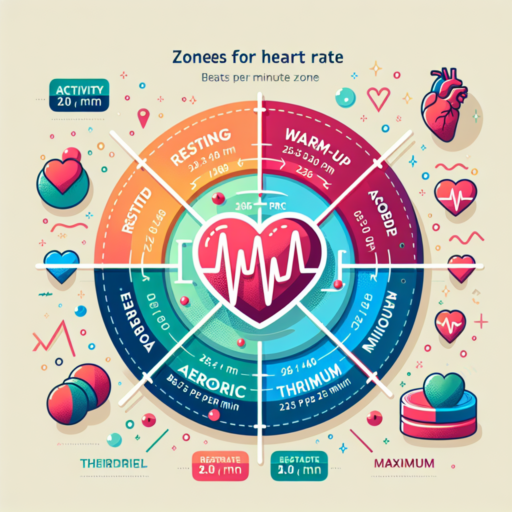What heart rate zones should you be in?
Understanding the different heart rate zones is crucial for maximizing your workout effectiveness and ensuring you train in a manner that’s suited to your personal fitness goals. Each zone represents a specific percentage of your maximum heart rate (MHR) and serves various purposes, from enhancing basic endurance to improving high-intensity athletic performance.
The Five Essential Heart Rate Zones
- Zone 1 (50-60% of MHR): This is the very light zone, perfect for warming up and cooling down. Training in this zone helps in recovery and gets you ready for more intense workouts.
- Zone 2 (60-70% of MHR): Known as the light zone, it’s where you enhance basic endurance and fat burning. It’s sustainable for long durations, making it ideal for building aerobic base.
- Zone 3 (70-80% of MHR): This moderate zone is where you improve aerobic fitness. Training here improves your pace and breathing, suitable for moderate-length workouts.
- Zone 4 (80-90% of MHR): Entering the high zone, where you increase maximum performance capacity. This is for improving speed and could be challenging to maintain for long periods.
- Zone 5 (90-100% of MHR): The peak zone, aimed at building anaerobic fitness. This is where you push your limits, suitable for short, intense bursts.
Choosing the right heart rate zone depends on your current fitness level, your training goals, and your overall health. For instance, beginners might spend most of their training time in zones 1 and 2 to build up endurance and strength without overexerting. In contrast, more experienced athletes might focus on zones 3 to 5 to enhance their performance and speed. Remember, it’s essential to consult with a fitness professional to determine your MHR accurately and to plan your training sessions safely based on these zones.
No se han encontrado productos.
What are my heart rate zones for my age?
Understanding your heart rate zones is crucial for maximizing your workout effectiveness and ensuring you train within safe limits. Each zone reflects a percentage of your maximum heart rate (MHR), which varies not only by your physical condition but also significantly by age. Knowing your specific zones can help tailor your exercise regimen for better results and increased safety.
Calculating Your Maximum Heart Rate
The most common method to calculate your MHR is by subtracting your age from 220. This formula provides a baseline to determine your heart rate zones. For example, a 30-year-old would have an estimated MHR of 190 beats per minute (220 minus 30 equals 190). It’s essential to remember that this is an approximation, and individual heart rates can vary.
Understanding Heart Rate Zones
There are typically five heart rate zones, each offering different benefits, from enhancing basic endurance to improving high-intensity performance:
- Zone 1 (50-60% of MHR): This is the very light intensity zone, ideal for warming up and cooling down. It aids in recovery and gets your body ready for more intense workouts.
- Zone 2 (60-70% of MHR): Known as the fat-burning zone, exercising at this intensity can help improve your body’s ability to use fat as a fuel source.
- Zone 3 (70-80% of MHR): This aerobic zone improves cardiovascular and respiratory health, increasing the size and strength of your heart.
- Zone 4 (80-90% of MHR): Entering this zone starts to push into anaerobic territory, enhancing your lactic acid system and improving high-intensity endurance.
- Zone 5 (90-100% of MHR): This is your peak effort, used for short bursts of high-intensity training that improve speed and power.
Knowing and respecting your heart rate zones based on your age can drastically improve the efficiency of your workouts and lower the risk of overtraining or injury. By aligning your exercise goals with the appropriate heart rate zones, you create a tailored fitness plan that caters to your body’s needs and limitations.
What is a good heart rate range for my age?
Understanding the ideal heart rate range based on your age is crucial for maintaining optimal health and fitness levels. As we age, the normal heart rate range tends to shift, reflecting changes in cardiovascular efficiency and overall fitness. Knowing your target heart rate can guide you in moderating your exercise intensity to stay within a healthy range, enhancing the benefits of physical activity without overexerting your heart.
General Guidelines for Heart Rate Ranges
Generally, a resting heart rate for adults ranges from 60 to 100 beats per minute (bpm). However, athletes or highly physically active individuals may observe lower resting rates due to better cardiovascular health. As for the maximum heart rate, a standard formula is 220 minus your age. This figure helps in determining your recommended heart rate zones for exercise, which usually range from 50% to 85% of your maximum heart rate, tailored to your fitness goals and health needs.
Age-Specific Heart Rate Considerations
Different age groups have varying target heart rate zones. For example, a 20-year-old’s estimated maximum heart rate could be around 200 bpm (220 minus 20), while for someone aged 50, it would be roughly 170 bpm (220 minus 50). These numbers serve as benchmarks for assessing whether you’re exercising within a heart rate range that is beneficial for your cardiovascular system. Engaging in regular physical activities that align with these heart rate zones can contribute significantly to cardiovascular health, endurance improvement, and effective weight management.
How do I work out my heart rate zones?
Understanding your heart rate zones is pivotal for maximizing your cardio workouts and tracking your fitness progress. Every individual’s fitness level and heart rate zones are unique, which necessitates a personalized approach to determining these zones. The process involves a few straightforward steps that can help you customize your physical activities according to your heart’s capacity.
Step 1: Determine Your Maximum Heart Rate (MHR)
The first step in working out your heart rate zones is to establish your Maximum Heart Rate (MHR). A common method to estimate your MHR is to subtract your age from 220. For example, a 30-year-old would have an estimated MHR of 190 beats per minute (bpm). However, remember that this method provides an estimate, and your true MHR can vary.
Step 2: Calculate Your Heart Rate Zones
Once you know your MHR, you can calculate your heart rate zones. These zones are typically expressed as percentages of your MHR and they categorize the intensity of your workouts. For instance, the moderate-intensity zone might be from 50% to 70% of your MHR, making it ideal for weight loss and improving cardiovascular health. To calculate, simply multiply your MHR by the desired percentage. Utilizing our previous example, 70% of a 190 MHR would be 133 bpm. This process enables you to target specific zones during your workouts for tailored fitness goals.
Understanding Your Zones
Different heart rate zones cater to various fitness objectives, from burning fat to enhancing aerobic and anaerobic capacities. The fat burn zone focuses on lower intensity workouts that help your body burn fat more efficiently, whereas the cardio zone increases your heart rate and is excellent for improving your vascular system and overall endurance. Knowing which zone to aim for depending on your fitness goals can lead to more effective workout sessions and better health outcomes.




